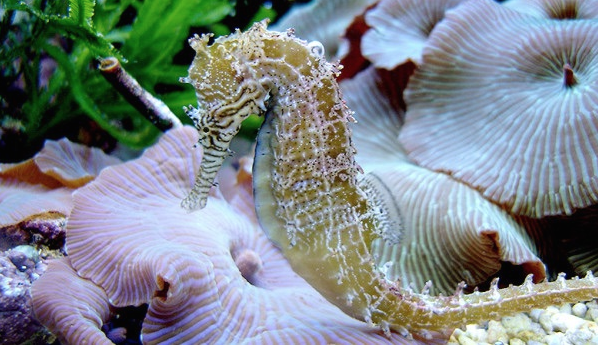
by Rick O'Connor | Feb 3, 2022
Seahorses are one of the coolest creatures on this planet – period. I mean who doesn’t like seahorses? People state “I love snakes”, “I hate snakes”, “I love sharks”, “I hate sharks”. But no one says, “I hate seahorses”. They are sort of in the same boat with sea turtles, everyone loves sea turtles. They are an icon of the sea, logos for beach products and coastal HOAs, underwater cartoons and tourist development boards, diving clubs and local restaurants. But have you ever seen one? I mean beyond seeing one at a local aquarium or such, have you ever found one while snorkeling on one of our beaches?
Most would say no.
I have lived in the panhandle all my life and have spent much of it in the water, and I can count on both hands the number of times I have encountered a seahorse while at the beach. Most encounters have been while seining. I cannot count on both hands how many times I have pulled a seine net here but very few of them did a seahorse encounter occur. When they did, it was over grassbeds. In each encounter the animal was lying in the grass not wriggling like the other fish, just lying there. It would be very easy to miss them discarding it as “grass”. It makes you wonder how many times I captured one and did not know it. When we did find one it was VERY exciting. My students would often scream “I had NO idea they lived here!”.
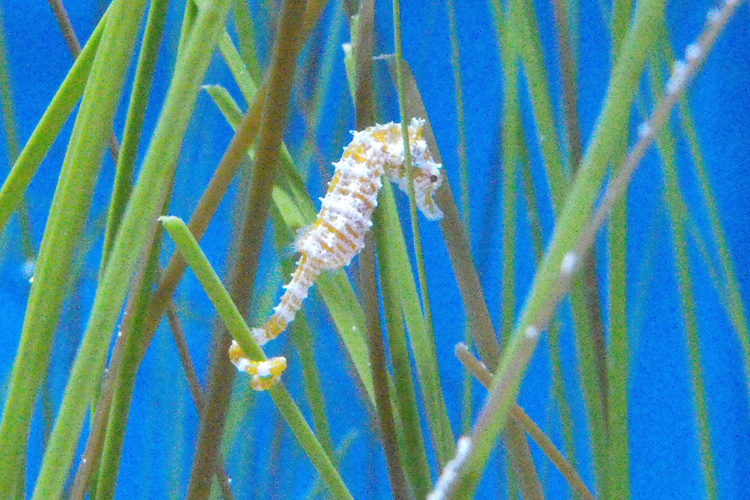
The seahorse Photo: NOAA
However, if you tried searching for them while snorkeling, which I have, the encounter rate is zero. But this makes sense. These animals are so well camouflaged in the grass it would be a miracle to find one just hanging there. This is by necessity really. If you have ever watched a seahorse in an aquarium they are not very “fleet of foot”. Escaping a predator by dashing away is not one of their finer skills. No, they must blend in and remain motionless if trouble, like a snorkeler, comes by.
But I have seen one while diving. It was a night dive near the Bob Sikes Bridge on Pensacola Beach about 40 years ago. We were exploring when my light swung over to see this large seahorse extended from a pipe that was coming out of some debris on the bottom. I was jubilated and screamed, as best you can while using SCUBA, for my partners to come check this out. We were all amazed and my interest in these animals increased.
When I attended Dauphin Island Sea Lab (DISL) as an undergraduate student, like many in the 1970s, I thought I would get involved with sharks, but I quickly developed a love for estuaries and my interest in seahorses returned. I made a visit to the library there and found very little in the literature, at that time, which piqued my interest even more. My senior year we had to complete a project where we had to collect, and correctly identify, 80 species of fish to pass the class. I asked the crew of the research vessel at DISL if they had ever found seahorses. They responded yes and took me to what they called their “seahorse spot”. We caught some. It was very cool. And yes… seahorses do exist here in the wild.
But what is this amazing animal?
What do I mean by this? As a marine science instructor, I would give my students what are called a lab practical’s. Assorted marine organisms would be scattered around the room and the students had to give their common name, phylum name, class name, and answer some natural history question I would ask. Snails are mollusk, mackerel are fish, jellyfish are cnidarians, and then they would come to the seahorse. Seahorses were… well… seahorses! What the heck are they?
Many of you may know they are fish. But over the years of teaching marine science, I found that many students were not sure of that. The definition of a fish is an animal with a backbone that possesses a scaly body, paired fins (usually), and gills. Seahorses have all that. There is a backbone no doubt. The scales are not as obvious because they are actually fused together in a sort of armor. The paired fins and gills are there. Yep… they are fish, but a fish (horse) of a different color.

This seahorse is a species from Indonesia.
Photo: California Sea Grant.
First, they are one of about 13 families of fish in the Gulf of Mexico that lack ventral fins, those on the belly side of their bodies. Second, they lack a caudal fin (the fish tail) and have a more prehensile tail for grabbing objects. Third, they swim vertically instead of horizontally as most fish do. Again, there is nothing about their body design that says “speed”.
Another thing I find fascinating about these animals is their global distribution. You might recall that the initial focus of this series on Florida panhandle vertebrates was the biogeography of these creatures. Seahorses are found all over the world. There are over 350 species of them. But the interesting question is: how would a seahorse living in the northern Gulf of Mexico reach Melbourne Australia? It makes sense that being so far apart there would be such differences in looks and genetics that they would be classified as different species, but how did an animal like a seahorse disperse across a large ocean like the Pacific?
Honestly, I can say the same for ghost crabs, which I found on the beaches of Hawaii. How did they get there? But that is another story.
My best guess was the dispersal occurred at a time when the two continents were closer together. The Pangea days, or some time close to that period. And as the continents “drifted” the seahorses remained close to their shorelines and moved apart. They may have been able to “island hop” across coral reefs to other Indonesian Islands, but those here in the United States were long lost relatives that changed in their appearance and lifestyles due to the large separation from others. That is my two cents anyway.
Hoese and Moore1 list two species of seahorses found here in the northern Gulf of Mexico. The Lined Seahorse and the Dwarf Seahorse.
The Lined Seahorse (Hippocampus erectus) is the larger of the two, reaching an average length of five inches. This is the one I found near the Bob Sikes Bridge all those years ago. Like all seahorses they are well adapted to life in debris where they can grab on to something with their prehensile tail and feed on small zooplankton using their vacuum like tube snout. Like all seahorses, the males have a brood pouch that holds the fertilized eggs producing live birth – another “live bearer”. They are usually dark in color, but gold individuals have been reported. Some have filamentous threads on their bodies making them look even more like plants. Their biogeographic distribution is amazing. They are found from Nova Scotia, throughout the tropics, all the way to Argentina. This suggests few biogeographic barriers, other than substrate to hide in.
The Dwarf Seahorse (Hippocampus zosterae) – also known as the pygmy seahorse – is much smaller, with a mean length of 1.5 inches. That would qualify as “dwarf” or “pygmy”. How would you ever find these? Other than size, the difference between these two are the number of rays (soft spines) in their fins. They can be counted, but its not fun, especially with a 1.5” seahorse. This guy prefers high salinity, actually, I have found that most seahorses do. This one is more tropical in distribution.
There is a third Florida species, the long snout seahorse (Hippocampus redi) that is found on the Atlantic coast, but not in the Gulf.
The strange thing about the seahorses in Florida, has been the declining encounters over the last few decades. For a creature that seems to have few barriers, they have found trouble somewhere. Maybe the loss of habitat, maybe a population crash due to the common practice years ago of capture and drying out for tourists to buy. It could be a change in environmental conditions such as salinity in the Pensacola Bay area. I am not sure. The more I write this article, the more my interest in this fish returns. As many researchers and wildlife managers have mentioned, this is an animal who has “fallen through the cracks”. People notice the changes in sea turtle and manatee encounters, but not seahorses. Maybe it is time we pay more attention to them and see how they are doing. I for one would hate to see the decline of this creature here in the panhandle.
Reference
Hoese, H.D., Moore, R.H. 1977. Fishes of the Gulf of Mexico; Texas, Louisiana, and Adjacent Waters. Texas A&M Press, College Station, TX. Pp. 327.

by Rick O'Connor | Feb 3, 2022
Based on our seine surveys along the beaches of most estuaries in the Florida panhandle, this is one of the most abundant fish in our bays. No matter the time of year, or the location, estuarine seining usually includes numerous individuals of this group. It is very apparent the importance they play in the food web of our local bays.

The silverside, or “glass” minnow.
Photo: U.S. Geological Survey
Those visiting and recreating in our waters probably are not aware of the numerous individuals of this fish schooling all around them. They are almost transparent and are often called “glass minnows” because of this. So, you do not really see them – even if you are snorkeling. But take a small hand net or a seine net and you will quickly discover they are there – and a lot of them.
They are small three-inch fish that are long, and tube shaped with forked (lunate) tails. Their bodies have a slight yellow-green appearance on the dorsal side, but much is a whiteish in color or transparent all together. They do have a broad silver stripe that runs laterally along their body and is where they get their common name “silversides”. Anchovies also have this “silverside” and are found in the same locations but differ from the silversides in that they have a more “shark looking snout” and only one dorsal fin, compared to the two dorsal fins found on the silversides.
It is apparent this whiteish, transparent color and silver stripe are effective in avoiding predation. Again, you and I do not see them while we are snorkeling. But is also apparent that many are consumed due to the large number you find in their schools. I have found from my seining surveys this fish is often collected on days when no other species are. The heat of summer, the cool of winter, during and after storms, high humidity, it does not matter – I always captured them. I have captured them over sandy beaches, over seagrasses, near jetties, and in the muck and mire of salt marshes. They are literally everywhere. I also capture them more frequently than I do anchovies, suggesting their importance to the health of the estuarine food web. It is one of the first fish my students learned to identify because of how frequently we caught them.
In the northern Gulf, there are two species found in local estuaries – the rough silverside and the tidewater silverside. Hoese and Moore1 do report a third species similar to the tidewater silverside that is more tolerant of saltwater.
The Rough Silverside (Membras martinica) is called so because their body scales are serrated and are “rough to the touch”. This is when you slide your fingers from the back towards the head, your fingers will feel the serrations and it is rough to the touch.
The Tidewater Silverside (Menidia beryllina) is smooth to the touch because their scales lack serrations. Other than that, these two fish look very similar. Tidewater silversides seem to be restricted to the shorelines and do not venture to the extended grassbeds off the beach. The third species mentioned M. peninsulae, is reported to prefer salinities at and above 19 ppt, where the tidewater prefers lower salinities. There is little else mentioned to distinguish these two, but I have seen both names reported in the scientific literature from researchers sampling our bay.
Both species of silversides have a large biogeographic distribution. Ranging from the colder waters of New York, all along the eastern seaboard, and the entire Gulf of Mexico.
You may not see them often, but know they are an important part of the estuarine ecology.
Reference
Hoese, H.D., Moore, R. H. 1977. Fishes of the Gulf of Mexico; Texas, Louisiana, and Adjacent Waters. Texas A&M Press, College Station TX. Pp. 327.
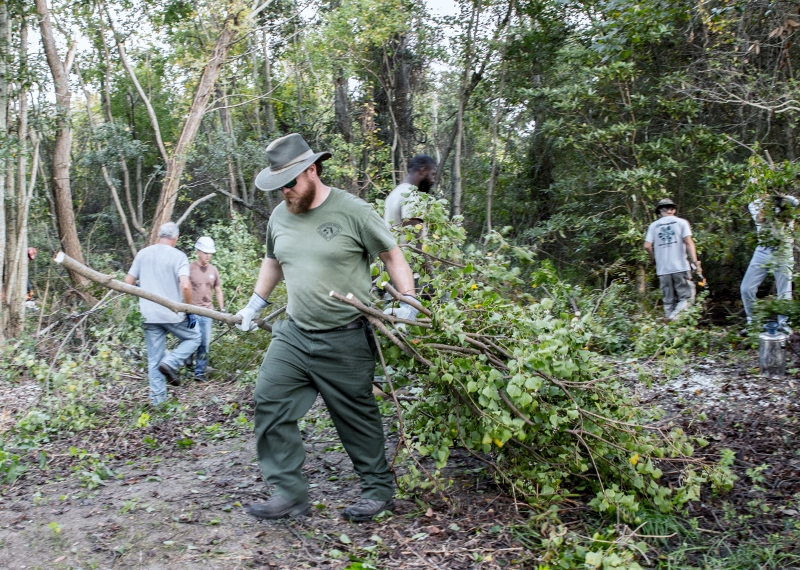
by Rick O'Connor | Jan 27, 2022
What is the Weed Wrangle?
It is a national event held every February where members of local communities visit a public area to remove invasive plants. However, due to COVID, we are again doing it “virtually” this year. Virtually meaning that members of the local community work in their own yards to remove invasive plants. This year in the western Florida panhandle we are targeting the Chinese tallow, but of course you are welcome to remove ANY invasive plant you may have.

The round-ish ovate leaves of the Chinese Tallow.
Photo: Rick O’Connor
How do you DO the Weed Wrangle?
Step 1 – Survey your property to see if you have any Chinese tallow. This tree is also known by many as the “popcorn tree”. You can work with other members on your street who are interested and identify Chinese tallow on your block.
Step 2 – Confirm the identification. If you are sure it is Chinese tallow, and many are very familiar with this plant and is why we have chosen it, you are good to go. If not, you can contact your county extension office for verification.
Step 3 – Report the tree(s) to the national database EDDMapS at www.EDDMapS.org. There is a “report sightings” button on the tool bar. It will ask for latitude and longitude and you can get this information from your phone or a GPS or from google earth if you have it on your computer. Remember to type in longitude as a negative number, -87 in our case, so that it is reported in the correct hemisphere. NOTE: You are not allowed to report plants on someone else’s property without their permission, please get that before you do.
Step 4 – Remove it. Please take photo of the tree(s) BEFORE you remove. Not everyone wants to remove their Chinese tallow. Even though it is an invasive species and listed as a state noxious weed. Many enjoy the tree, and the color changes it provides. There is nothing illegal about having the tree in your yard, so you are fine. If you do choose to remove it there are methods that have been tested that work best. Contact your county extension office for those methods so that you are successful. Please take photo after removal.
Step 5 – Contact me – Rick O’Connor, Escambia County Extension, at roc1@ufl.edu to let me know you which steps you completed. I am tracking participation in this years Weed Wrangle. We will be doing this during the month of February. We also can enter you into a drawing for prizes!
If there are other invasive plants on your property you are interested in removing and want to know the best methods to do so, contact your county extension office and we can provide that for you. It would certainly be included in this years Weed Wrangle.
Thanks for helping stay on top of our invasive species problem.

Members of the Six Rivers CISMA remove Chinese tallow from a city park in Pensacola.
Photo: Kristal Walsh.
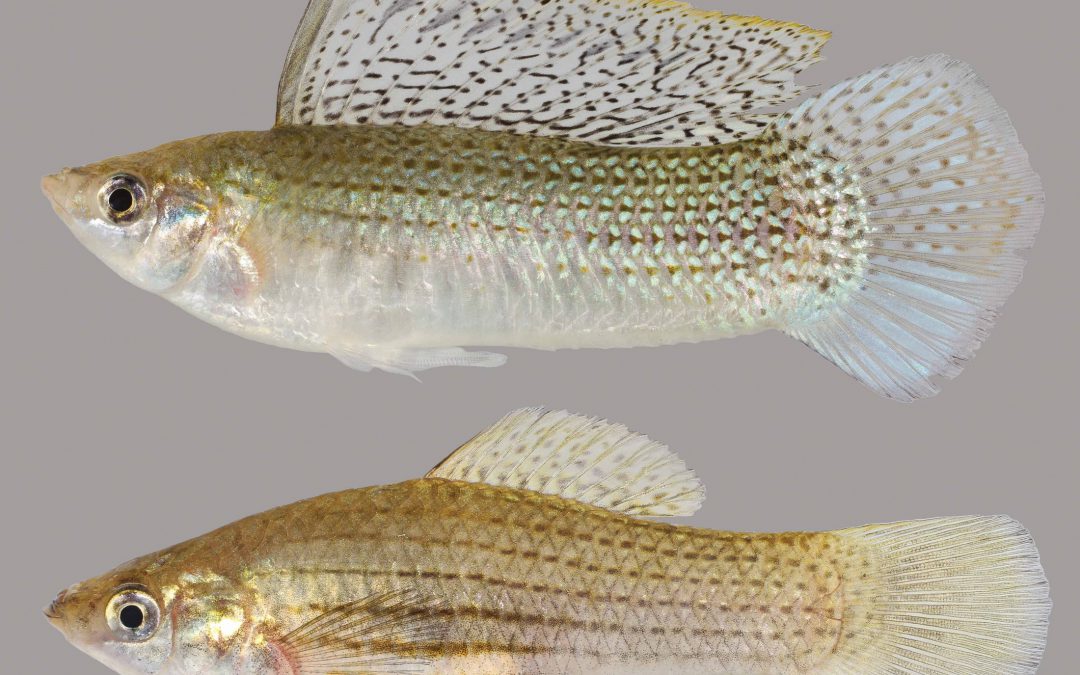
by Rick O'Connor | Jan 27, 2022
Members of the family Poeciliidae are what many call “livebearers”. Live bearing meaning they do lay eggs as most fish do, but rather give birth to live young. But this is not to be confused with live-bearing you find in mammals – which is different.
Most fish lay eggs. The females and males typically have a courtship ritual that ends with the female’s eggs (roe) being laid on some substrate, or released into the water column, and the male’s sperm (milt) are released over them. Once fertilized the gelatinous covered eggs begin to develop.
Everything the developing young need to survive is provide within the egg. The embryo is suspended in a semi-gelatinous fluid called the amnion. Oxygen and carbon dioxide gas exchange occurs through this amnion and through the gelatinous covering of the egg itself. Food is provided in the form of yolk, which is found in a sac attached to the embryo. There is a second sac, the allantois, where waste is deposited. When the yolk is low and the allantois full – it is time to hatch. This usually occurs in just a few days and often the baby fish (fry) are born with the yolk sac still attached. Parental care is rare, they are usually on their own.
With “livebearers” in the family Poecillidae it is different.
The males have a modified anal fin called a gonopodium. They fertilize the roe not externally but rather internally – more like mammals. The fertilized eggs develop the same as those of other fish. There is a yolk sac and allantois, and the embryo is covered in amnion within the gelatinous egg covering. But these eggs are held WITHIN the female, not laid on the substrate or released into the water column. When they hatch the live fry swim from the mother into the bright new world – hence the term “livebearer”.
There are advantages to this method. The eggs are protected inside the mother, and she obviously provides parental care to her offspring. However, this does make her much slower and an easier target for predators. There is some give and take.
This differs from the “live-bearing” of most mammals in that there is still an egg. Mammals do still have a yolk sac but feeding and removing waste is done THROUGH THE MOTHER. Meaning the embryo is attached to the mother via an umbilical cord where the mother provides food and removes waste trough her placenta. There is no classic egg in this case. I say most mammals because there are two who live in Australia that still do lay eggs – the platypus and the spiny anteater, and the marsupials (kangaroos and opossums) are a little different as well – but marsupials do no lay eggs.
Biologists have terms for these. Oviparous are vertebrates that lay eggs – such as fish, frogs, turtles, and birds. Ovoviviparous are vertebrates that produce eggs but keep them within the mother where they hatch – such as some sharks, some snakes, and the live bearing fish we are talking about here. Then there are the viviparous vertebrates that do not have an egg but rather the embryo is attached, and fed by, the mother herself – like most mammals.
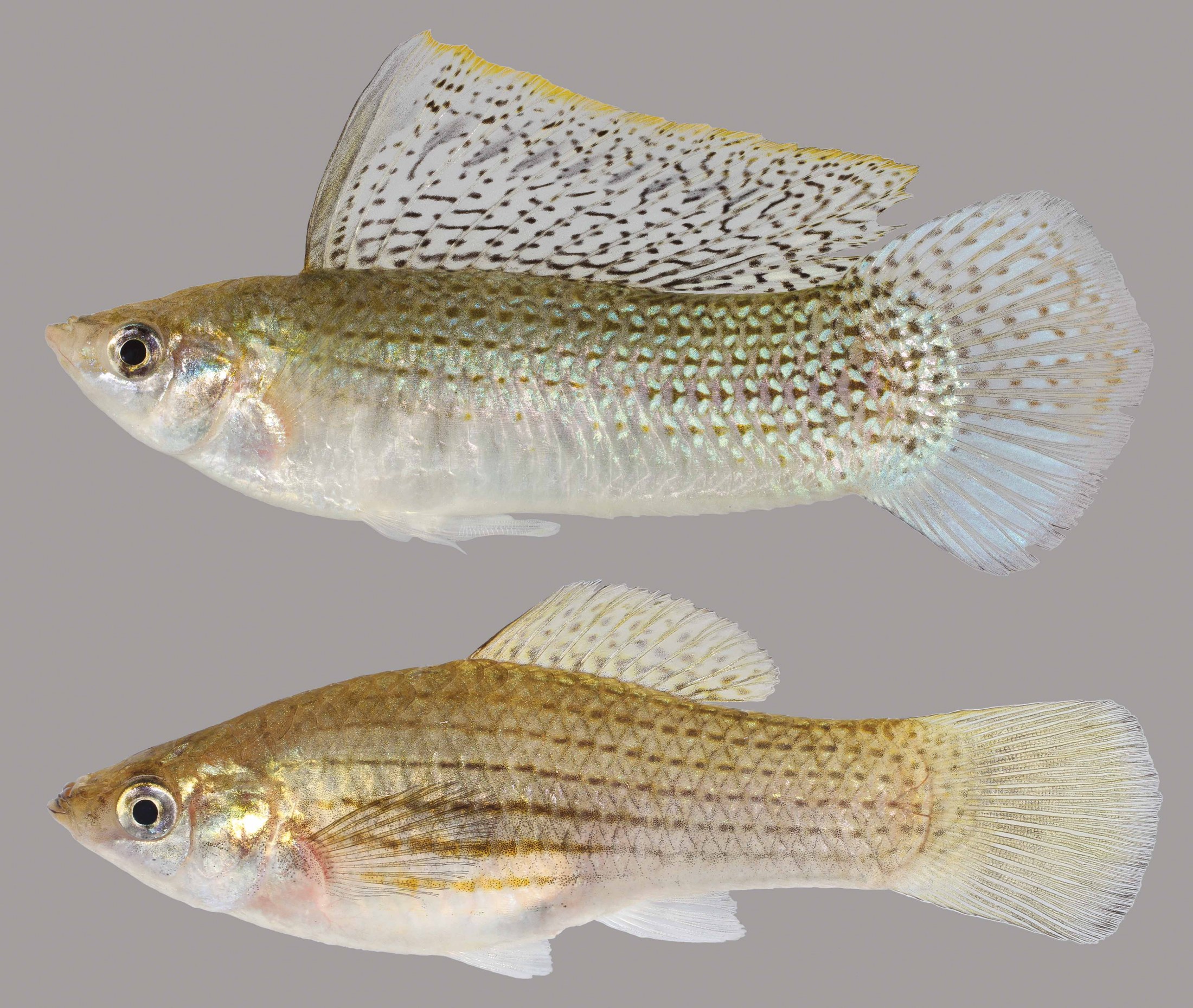
Sailfin Molly. The male is the fish above with the large “sailfin”. Note the gonopodium on his ventral side.
Photo: University of Florida
The livebearers of the family Poeciliidae are ovoviviparous. They are primarily small freshwater fish that are very popular in the aquarium trade. But there are two species that can tolerate saltwater and enter the estuaries of the northern Gulf of Mexico: the sailfin molly and the mosquitofish.
The Sailfin Molly (Poecilia latipinna) is the same fish sold in aquarium stores as the black molly. The black phase is quite common in freshwater habitats, but in the estuarine marshes the fish is more of a gray color with lateral stripes that is made up of a series of dots. They are short-stout bodied fish and the males possess the large sail-like dorsal fin from which the species gets its common name. The females resemble the males albeit no large sailfin and most found are usually round and full of developing eggs. They are very common in local salt marshes and often found in isolated pools within these habitats. The biogeographic range of this species is restricted to the southern United States, reported from South Carolina throughout the Gulf of Mexico. One would guess temperature may be a barrier to their dispersal further north along the Atlantic seaboard.
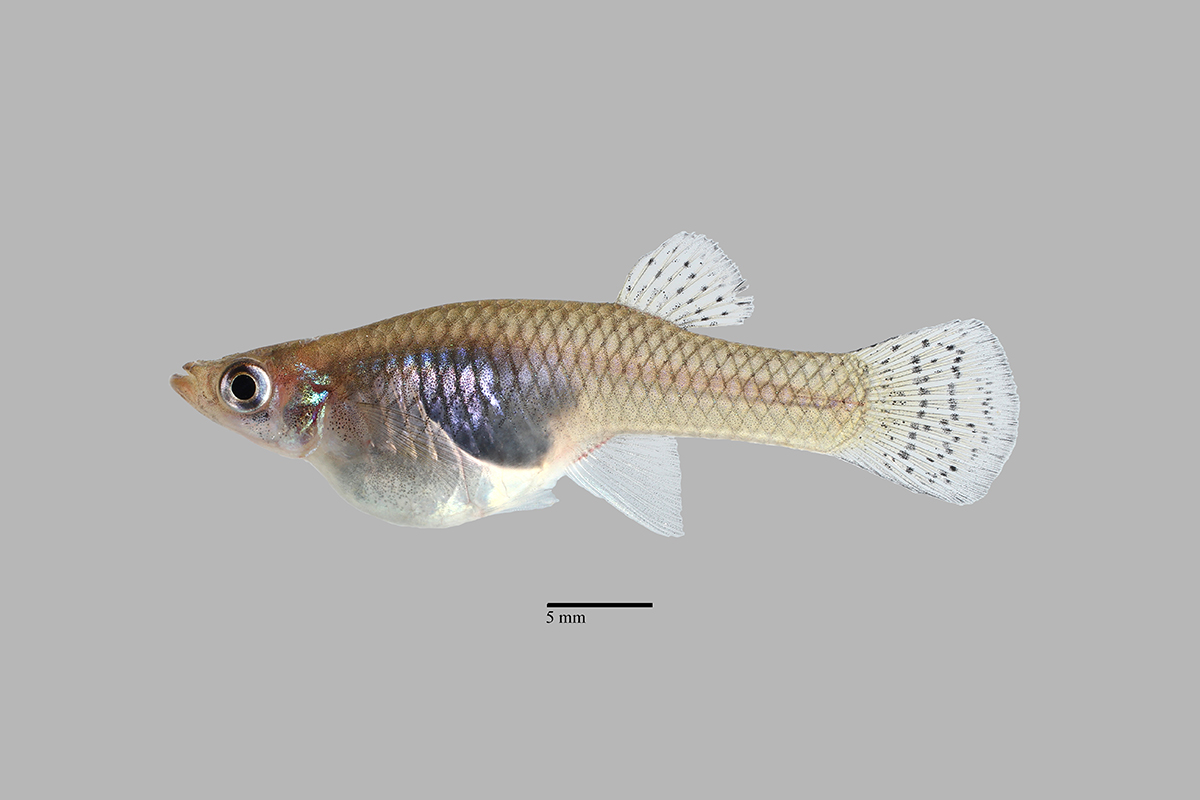
The mosquitofish.
Photo: University of Florida
The Mosquitofish (Gambusia affinis) is familiar to many people whether they know it or not. Those who know the fish know they are famous for the habit of consuming mosquito larva and some, including our county mosquito control unit, use them to control these unwanted flying insects. For those who may they are not familiar with it, this is the fish frequently seen in roadside ditches, ephemeral ponds that show up after rainstorms, retention ponds, and other scattered bodies of freshwater within the community. Most who see them call them “minnows”. There is always the question as to “where did they come from?” You have a vacant lot – it rains one day – these small fish show up – where did they come from? The same can be said for community retention ponds. The county comes in a digs a hole – it rains one day, and the retention pond fills – and there are fish in it. One explanation to their source is the movement of fish by wading birds, where the fish incidentally become attached to their feet. Again, they are often released intentionally to help control local mosquito populations. This fish is found in our coastal estuaries but does not seem to like saltwater as well as the sailfin molly. It is found in cooler water ranging throughout the Gulf and as far north as New Jersey.
Both of these fish make excellent aquarium pets, and the sailfin molly in particular can be beautiful to watch.
Reference
Hoese, H.D., Moore, R.H. 1977. Fishes of the Gulf of Mexico; Texas, Louisiana, and Adjacent Waters. Texas A&M Press, College Station TX. Pp. 327.
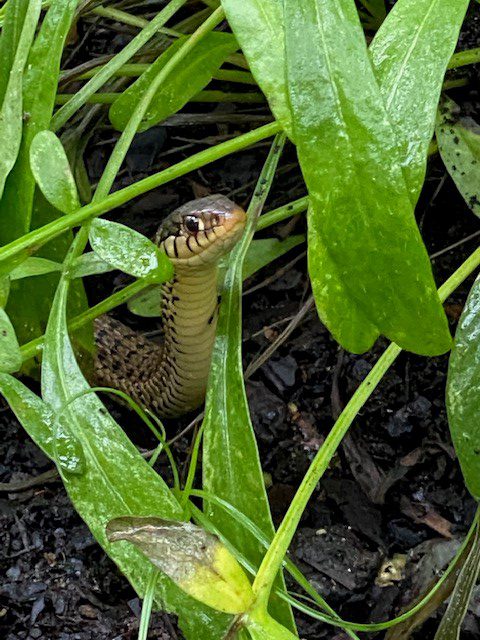
by Rick O'Connor | Jan 20, 2022
When hiking around the Florida panhandle in midwinter, most snakes are undercover trying to avoid the chilly cold fronts that pass through and can drop temperatures close to freezing. So, the probability of seeing one is low. But one species, the eastern garter snake, seems to tolerate cold temperatures better. They are often found basking on open areas this time of year and are quite common not only on the trails, but in our home landscapes as well.
But not to fear…
This is one of the 40 non-venomous snakes found in our state. Many are afraid of these animals because… well… because they are snakes, and that is all that need to be said – at least for some. But for others, they understand the benefits snakes provide to the ecosystem (controlling unwanted pests) and to see one is kind of exciting. Being non-venomous does not mean they will not bite, they certainly will, but no venom is associated with it. Larger non-venomous snake bites can be painful, but not deadly. Garter snake bites barely hurt.

The eastern garter snake is one of the few who are active during the cold months.
Photo: Molly O’Connor
Recently my wife and I were on a hike with our grandsons in central Escambia County. At one point my oldest grandson said “snake”. I am not sure how he saw it actually. It was a young eastern garter snake basking in the middle of the trail. These snakes have colorful patterns of stripes and squares that help them blend in well. We knew right away what it was and were all excited to see it. Knowing it was harmless we allowed him to pick it up but warned him that it would most likely bite. Garter snakes tend to flee when first alarmed but will turn and bite if cornered. They will sometimes rattle their tails in the leaves giving off a “buzzing” sound and can release a musk to warn the predator. But this young snake did neither, no rattling, no musk. However, it did try to bite him. After a few photos and the amazement of seeing one, we released it in a sunny spot to continue its midday basking. It was pretty cool.
Many reading this have seen many garter snakes and know this as a harmless animal. They are found all across the state of Florida and much of the eastern United States. There is a subspecies, the blue-striped garter snake, that can be found in the Big Bend area of Florida, but the differences are minor.
Eastern garter snakes are smaller snakes, usually reaching two feet but there is a four-footer on record. They like to inhabit areas that are near water where their favorite prey (amphibians) can be found. Preferring open grassy areas, they can be found in wooded habitats and are often found in lawns and gardens of local neighborhoods.
They hunt primarily during the daylight hours for amphibians but will also eat fish and earthworms. Some have been found to feed on snails, slugs, and even small snakes, birds, and mammals. They are not constrictors but rather grab their prey and swallow it whole.
They are famous for their large gatherings during breeding season. In spring, females will release a pheromone to attract the males, and the males will come, many of them at one time. There are locations in Canada where literally thousands gather at one location. The females do not lay eggs but rather give birth to about 20-30 live young in late summer or fall, it could be up to 100 in a litter. These large groups of slithering garters bring back images from movies where “snake pits” and “a den of snakes” are portrayed. I have never seen such a gathering, and in the southeast, they do not happen in such large numbers as these, but it would be cool.
This time of year, on sunny days in open basking areas, you may see this small but neat snake. The same could be true if hiking near an open sunny location. So, keep your eyes down and maybe you will get lucky.
References
Common Garter Snake. 2021. Florida Snake ID Guide. Florida Museum of Natural History. Common Gartersnake – Florida Snake ID Guide (ufl.edu).
Gibbons, W. 2017. Snakes of the Eastern United States. University of Georgia Press, Athens GA. Pp. 416.
Gibbons, W., Dorcas, M. 2007. Snakes of the Southeast. University of Georgia Press, Athens GA. Pp. 253.









